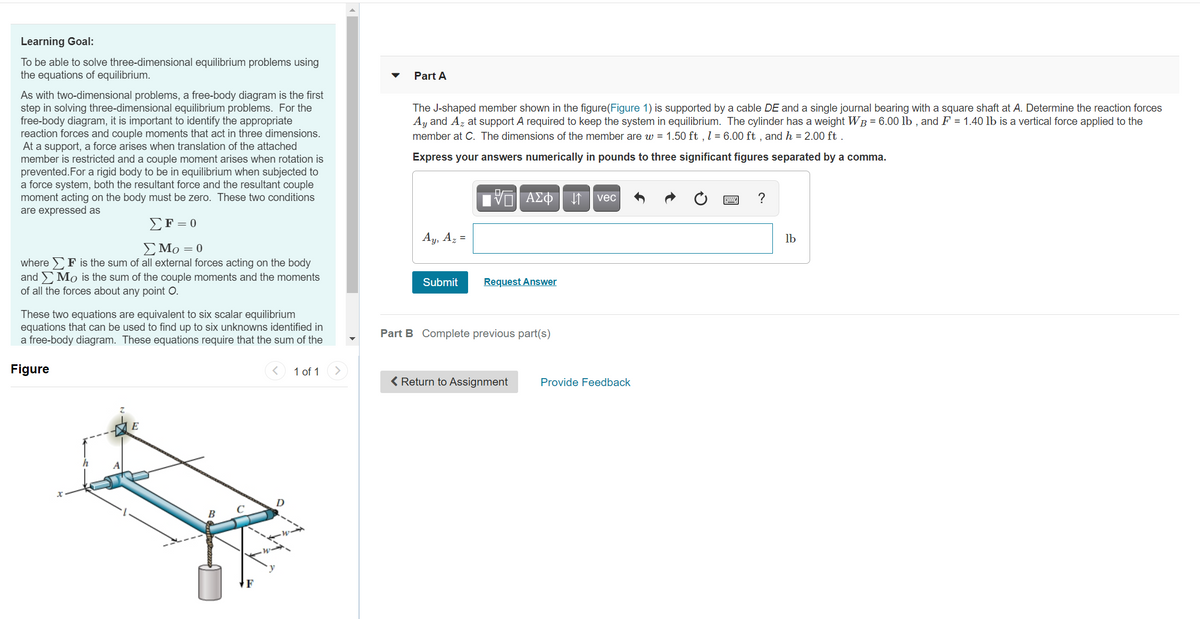Part A The J-shaped member shown in the figure(Figure 1) is supported by a cable DE and a single journal bearing with a square shaft at A. Determine the reaction forces A, and A, at support A required to keep the system in equilibrium. The cylinder has a weight WB = 6.00 lb , and F =1.40 lb is a vertical force applied to the member at C. The dimensions of the member are w = 1.50 ft , 1 = 6.00 ft , and h = 2.00 ft. Express your answers numerically in pounds to three significant figures separated by a comma. AZO vec ?
Part A The J-shaped member shown in the figure(Figure 1) is supported by a cable DE and a single journal bearing with a square shaft at A. Determine the reaction forces A, and A, at support A required to keep the system in equilibrium. The cylinder has a weight WB = 6.00 lb , and F =1.40 lb is a vertical force applied to the member at C. The dimensions of the member are w = 1.50 ft , 1 = 6.00 ft , and h = 2.00 ft. Express your answers numerically in pounds to three significant figures separated by a comma. AZO vec ?
International Edition---engineering Mechanics: Statics, 4th Edition
4th Edition
ISBN:9781305501607
Author:Andrew Pytel And Jaan Kiusalaas
Publisher:Andrew Pytel And Jaan Kiusalaas
Chapter10: Virtual Work And Potential Energy
Section: Chapter Questions
Problem 10.54P: The mechanism of negligible weight supports the weight W. Find the value of for equilibrium. Is the...
Related questions
Question
100%

Transcribed Image Text:Learning Goal:
To be able to solve three-dimensional equilibrium problems using
the equations of equilibrium.
Part A
As with two-dimensional problems, a free-body diagram is the first
step in solving three-dimensional equilibrium problems. For the
free-body diagram, it is important to identify the appropriate
reaction forces and couple moments that act in three dimensions.
At a support, a force arises when translation of the attached
member is restricted and a couple moment arises when rotation is
prevented.For a rigid body to be in equilibrium when subjected to
a force system, both the resultant force and the resultant couple
moment acting on the body must be zero. These two conditions
are expressed as
The J-shaped member shown in the figure(Figure 1) is supported by a cable DE and a single journal bearing with a square shaft at A. Determine the reaction forces
Ay and Az at support A required to keep the system in equilibrium. The cylinder has a weight WB = 6.00 lb , and F = 1.40 lb is a vertical force applied to the
member at C. The dimensions of the member are w = 1.50 ft , l = 6.00 ft , and h = 2.00 ft .
Express your answers numerically in pounds to three significant figures separated by a comma.
ΑΣΦΨ
?
vec
ΣF=0
Ay, Az =
lb
EMo = 0
where F is the sum of all external forces acting on the body
and Mo is the sum of the couple moments and the moments
of all the forces about any point O.
Submit
Request Answer
These two equations are equivalent to six scalar equilibrium
equations that can be used to find up to six unknowns identified in
a free-body diagram. These equations require that the sum of the
Part B Complete previous part(s)
Figure
1 of 1
>
< Return to Assignment
Provide Feedback
E
D
B
Expert Solution
This question has been solved!
Explore an expertly crafted, step-by-step solution for a thorough understanding of key concepts.
This is a popular solution!
Trending now
This is a popular solution!
Step by step
Solved in 2 steps with 1 images

Knowledge Booster
Learn more about
Need a deep-dive on the concept behind this application? Look no further. Learn more about this topic, mechanical-engineering and related others by exploring similar questions and additional content below.Recommended textbooks for you

International Edition---engineering Mechanics: St…
Mechanical Engineering
ISBN:
9781305501607
Author:
Andrew Pytel And Jaan Kiusalaas
Publisher:
CENGAGE L

International Edition---engineering Mechanics: St…
Mechanical Engineering
ISBN:
9781305501607
Author:
Andrew Pytel And Jaan Kiusalaas
Publisher:
CENGAGE L